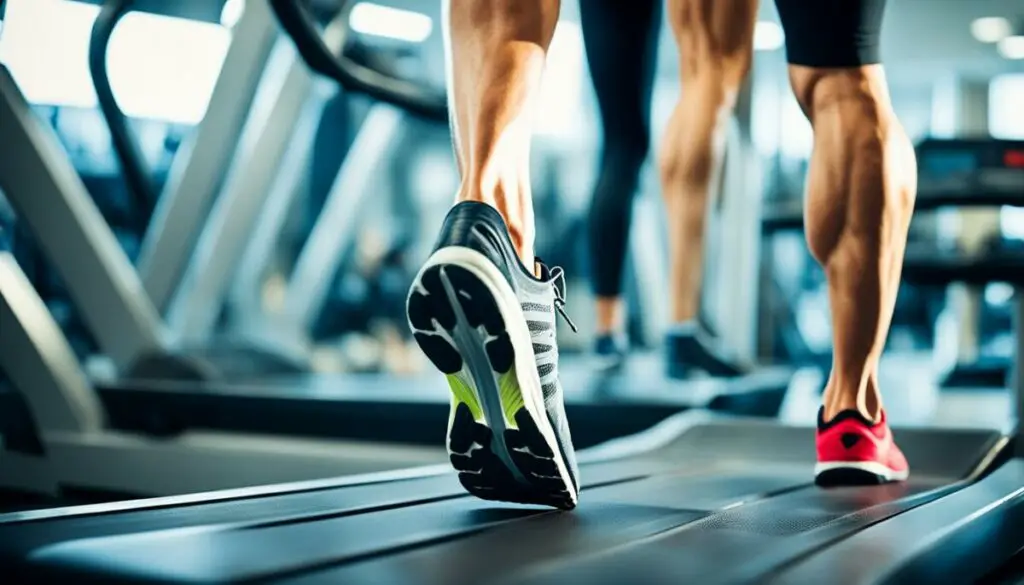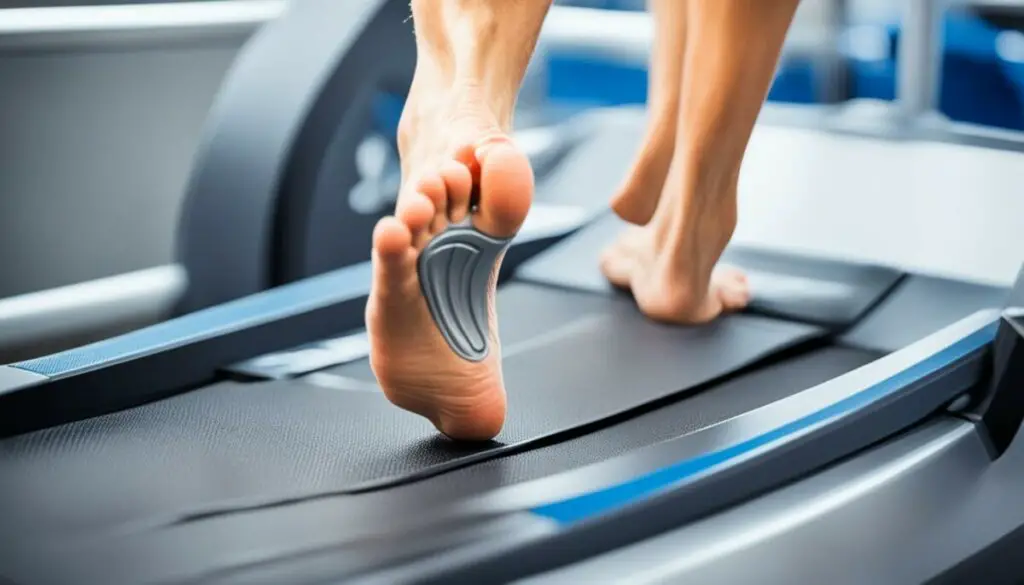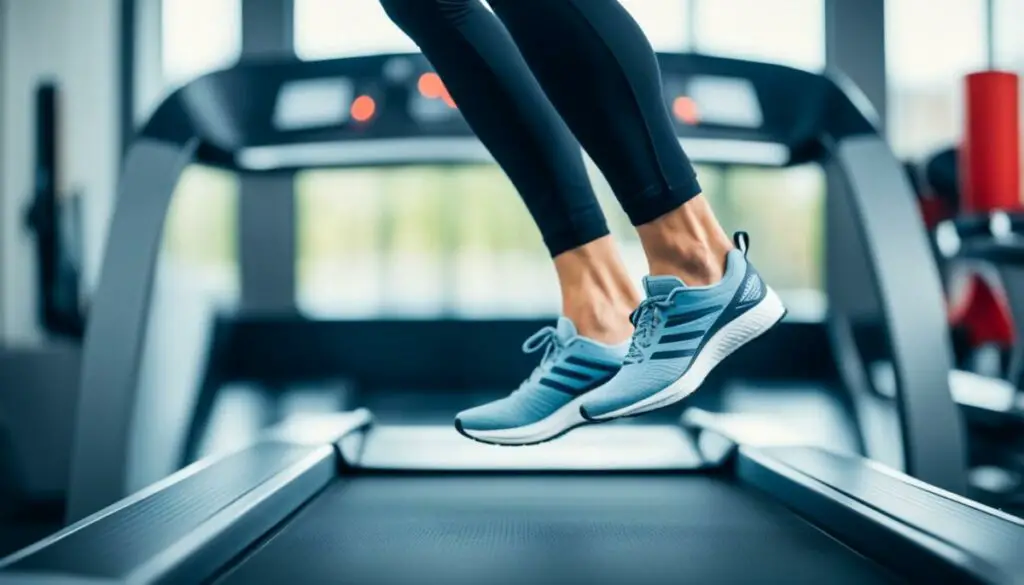Last Updated on 3 months by Francis
Running barefoot on a treadmill has gained popularity in recent years as a way to engage in a low-impact and natural running experience. Whether you’re a seasoned runner or just starting your fitness journey, you may be curious about the benefits and risks of this unique workout. In this article, we’ll explore the pros and cons of running barefoot on a treadmill, discuss proper form and injury prevention techniques, and provide tips for transitioning to this style of running.
Contents
Key Takeaways:
- Running barefoot on a treadmill can help strengthen the feet and legs and improve running form.
- It enhances balance, coordination, and proprioception.
- There are risks of injury, such as blisters and burns, if proper techniques and precautions aren’t followed.
- Gradually transitioning and listening to your body are essential for a successful barefoot treadmill running experience.
- A balanced approach, considering personal goals and preferences, is crucial when deciding to run barefoot on a treadmill.
Is Running Barefoot on a Treadmill Okay?

Running barefoot on a treadmill is an option that many runners consider. While some enjoy the natural feeling and benefits of barefoot running, others prefer the comfort and protection provided by shoes. Let’s explore the pros and cons of running barefoot on a treadmill and the potential risks involved.
Adjusting Your Running Form
Running Form: When opting for barefoot running on a treadmill, it’s essential to make adjustments to your running form. Focus on landing softly on your forefoot or midfoot, as opposed to a heavy heel strike. This helps to reduce the impact and strain on your joints.
The Pros and Cons
Wear Shoes on a Treadmill: Some runners prefer to wear shoes on a treadmill to provide extra cushioning and support, reducing the risk of foot and leg discomfort. Shoes can also protect your feet from blisters caused by the textured surface of the treadmill belt.
Running Barefoot on a Treadmill: On the other hand, running barefoot on a treadmill can help strengthen the muscles in your feet and legs. It promotes a more natural running gait and can improve balance and coordination. It may also reduce the risk of certain common running injuries.
Preventing Potential Risks
Potential Risks: Running barefoot on a treadmill does come with potential risks, such as blisters, burns, and stress injuries. To minimize these risks, it’s important to start gradually and listen to your body. If you experience any discomfort or pain, it may be a sign to adjust your running technique or consider wearing minimalist shoes.
Transitioning to Barefoot Running: If you decide to try barefoot running on a treadmill, it’s crucial to transition gradually. Start with short distances and gradually increase your running time. This allows your body to adapt to the new demands and reduces the risk of injury.
Comparison of Running Barefoot on a Treadmill vs. Wearing Shoes
| Running Barefoot on a Treadmill | Wearing Shoes on a Treadmill |
|---|---|
| Strengthens foot and leg muscles | Provides cushioning and support |
| Promotes a more natural running form | Reduces the risk of blisters and burns |
| Improves balance and coordination | Offers comfort and protection |
| Potential risk of blisters, burns, and stress injuries | May cause foot and leg discomfort |
When deciding whether to run barefoot on a treadmill or wear shoes, consider your individual needs, preferences, and goals. Take into account the potential risks and benefits, and make an informed choice that aligns with your running style and comfort level.
Benefits of Running Barefoot on a Treadmill

Running barefoot on a treadmill offers numerous benefits that can enhance both your physical and mental well-being. Let’s explore some of these advantages:
Strengthened Feet and Legs
Running without shoes on a treadmill engages the muscles in your feet and legs more intensively compared to running with cushioned shoes. This increased resistance helps to strengthen these muscle groups over time, leading to improved overall strength and stability.
Natural Gait and Improved Running Form
When running barefoot, your feet are able to move more naturally, allowing for a more efficient running gait. Without the restrictions of shoes, you’re more likely to adopt a midfoot or forefoot strike, which reduces the risk of overstriding and potential injuries. By developing a more natural running form, you can maximize your performance and minimize the impact on your joints.
Enhanced Balance and Coordination
Running barefoot on a treadmill requires increased balance and coordination due to the absence of cushioning and support. This activates the small stabilizing muscles in your feet and lower legs, improving your overall balance and proprioception. By incorporating barefoot running into your workout routine, you can enhance your body’s kinesthetic awareness and overall coordination.
Memory Improvement and Cognitive Function
Studies suggest that engaging in regular physical activity, such as running, can have a positive impact on memory and cognitive function. Running barefoot on a treadmill, with its increased sensory stimulation and activation of the feet’s nerve endings, may further enhance these cognitive benefits. So, lace up your shoes and hit the treadmill to improve not only your physical health but your mental acuity as well.
Safe Alternative to Road Running
Running barefoot on a treadmill eliminates the hazards associated with road running, making it a safer option for your workouts. With no risk of stepping on uneven surfaces, debris, or sharp objects, you can focus solely on your run without the worry of potential injuries. Additionally, treadmill running provides a controlled environment, allowing you to adjust speed and incline according to your fitness level and desired challenge.
Embrace the benefits of running barefoot on a treadmill, and experience the joys of strengthened feet and legs, improved natural gait, enhanced balance and coordination, and the peace of mind that comes with a safe and controlled running environment.
Risks of Running Barefoot on a Treadmill

While running barefoot on a treadmill has its benefits, it’s important to be aware of the potential risks involved. Without the cushioning and support of traditional running shoes, there is an increased risk of injuries.
The lack of protection can lead to various issues, including:
- Stress fractures: The repetitive impact on your feet and legs can increase the risk of stress fractures, which are small cracks in the bones.
- Shin splints: Barefoot treadmill running can put strain on the shinbones, leading to discomfort and pain.
- Plantar fasciitis: The absence of arch support can contribute to inflammation and pain in the plantar fascia, a band of tissue that connects the heel to the toes.
In addition to these injuries, the textured surface of the treadmill belt can cause blisters, calluses, and skin abrasions. These can be painful and interfere with your running routine.
Furthermore, the repetitive stress of treadmill running can also lead to overuse injuries. Continuous impact on the same muscles, tendons, and ligaments without proper rest and recovery can result in conditions such as tendonitis and muscle strains.
To minimize these risks, it’s crucial to take precautions and gradually transition to barefoot treadmill running. This allows your feet and legs to adapt to the new mechanics and build up the necessary strength and endurance.
Listen to your body and pay attention to any discomfort or pain. If you experience any persistent issues, it may be necessary to consult a healthcare professional for guidance and support.
Tips for Running Barefoot on a Treadmill

If you decide to try running barefoot on a treadmill, it’s important to follow a few tips for a safe and effective workout. Starting slowly and gradually increasing your running time and intensity will allow your feet and legs to adapt to this new form of exercise. Remember, Rome wasn’t built in a day! Take your time and be patient with your body’s adjustment process.
To minimize the impact on your joints, focus on shortening your stride and landing softly on your midfoot or forefoot. This will distribute the forces more evenly throughout your feet, reducing the risk of injury and discomfort. By practicing this running technique, you’ll help strengthen the muscles in your feet and lower legs, ultimately enhancing your running performance.
Starting slowly and gradually increasing your running time and intensity will allow your feet and legs to adapt to this new form of exercise.
Consider wearing socks or minimalist shoes while running barefoot on a treadmill. This will provide an extra layer of protection for your feet and help reduce the risk of blisters. Socks or minimalist shoes can also offer some cushioning and support without interfering with the natural movement of your feet.
Remember, running barefoot on a treadmill is a personal choice that may not be suitable for everyone. Take into account your comfort level, goals, and individual needs when deciding whether to give it a try.
Now, let’s take a look at a table summarizing the key tips for running barefoot on a treadmill:
| Tips for Running Barefoot on a Treadmill |
|---|
| Start slowly |
| Shorten your stride |
| Land softly on your midfoot or forefoot |
| Consider wearing socks or minimalist shoes |
By following these tips, you can enjoy the benefits of barefoot treadmill running while minimizing the risks. Remember, running should be a rewarding and enjoyable experience, so listen to your body and adjust your routine accordingly. Now, let’s move on to why people choose to run barefoot on a treadmill.
Why Do People Run Barefoot on a Treadmill?
Many runners choose to run barefoot on a treadmill because of the benefits it offers. Running without shoes, also known as minimalist running, allows for a more natural running stride and encourages landing on the forefoot or midfoot, rather than the heel. This promotes a more efficient and balanced running form.
One of the advantages of running barefoot on a treadmill is the improvement in balance and stability. When running without shoes, your body’s proprioceptors, which are sensory receptors in the feet, can better detect the surface and make quicker adjustments to maintain balance. This can lead to better overall stability during your runs.
Running barefoot on a treadmill allows for a more connected and efficient running experience.
For individuals with flat feet, running barefoot can be particularly beneficial. Flat feet can cause overpronation, where the feet roll inward excessively while running. This can lead to instability and potential injuries. By running barefoot, the muscles in the feet are strengthened, helping to correct overpronation and improve foot arch support.
In summary, running barefoot on a treadmill offers the advantages of minimalist running, a natural running stride that promotes better balance and stability, and the potential to strengthen the muscles in the feet, particularly for individuals with flat feet.
Is Walking Barefoot on a Treadmill Good for You?
Walking barefoot on a treadmill can be a fantastic way to enhance your fitness routine. Not only does it provide a unique and refreshing experience, but it also offers numerous benefits for your body and mind.
By walking barefoot on a treadmill, you can strengthen the muscles in your feet and legs. The natural movement of your feet without the restriction of shoes helps to engage and activate the muscles, leading to increased strength and stability.
Additionally, walking barefoot on a treadmill can improve your balance and stability. Without the cushioning and support of shoes, your body relies on its natural proprioceptive abilities to maintain balance, which can enhance your overall stability and coordination.
Another advantage of walking barefoot on a treadmill is the ability to adjust your stride and gait. Without shoes, your feet have the freedom to move in a more natural and comfortable way, allowing you to make subtle adjustments to your stride length and foot position. This can help improve your walking form and reduce the impact on your joints.
Overall, walking barefoot on a treadmill provides a low-impact yet effective workout. It’s a safe and enjoyable way to strengthen your muscles, improve your balance, and fine-tune your walking technique.
Walking barefoot on a treadmill allows you to reconnect with the ground beneath you and experience the freedom of natural movement.
Benefits of Walking Barefoot on a Treadmill:
- Strengthening of muscles in the feet and legs
- Improved balance and stability
- Adjustment and optimization of stride
- Enhanced proprioception and coordination
So if you’re looking for a new way to challenge yourself and reap the benefits of barefoot exercise, give walking barefoot on a treadmill a try. Just remember to start slowly, listen to your body, and enjoy the journey towards stronger, more balanced, and more confident strides.
The Verdict
The decision to run or walk barefoot on a treadmill ultimately depends on individual preference and the balance of benefits and risks. While there are clear advantages to barefoot treadmill running, such as improved foot and leg strength, enhanced running form, and better balance and coordination, there are also potential risks of injuries and discomfort.
One of the main benefits of barefoot treadmill running is the opportunity to strengthen the muscles in the feet and legs. By removing the cushioning of regular running shoes, barefoot running engages these muscles more intensely, leading to increased strength and stability over time.
In addition, running barefoot on a treadmill encourages a more natural running gait. Without the limitations of traditional running shoes, runners tend to land on the midfoot or forefoot, reducing the risk of overstriding and associated injuries. This natural running form can be beneficial for runners looking to improve their technique and reduce the impact on their joints.
Furthermore, barefoot treadmill running can improve balance and coordination. By relying on the feet’s proprioception and adapting to the treadmill’s surface, individuals can enhance their body’s ability to maintain stability and control. Studies also suggest that barefoot running may have cognitive benefits, including memory improvement.
Although barefoot treadmill running offers numerous advantages, it’s essential to consider the potential risks. Without the protective cushioning of shoes, there is an increased risk of developing blisters, burns, and other skin irritations from the friction caused by the treadmill belt. Additionally, the lack of support may put runners at a higher risk of stress fractures, shin splints, and other overuse injuries.
When deciding whether to try barefoot treadmill running, individuals should carefully weigh the pros and cons. It’s crucial to listen to your body, start gradually, and gradually increase intensity and mileage. By following proper techniques and utilizing protective measures such as socks or minimalist shoes, you can minimize the risks associated with barefoot treadmill running.
Table: Pros and Cons of Barefoot Treadmill Running
| Benefits | Risks |
|---|---|
| Improved foot and leg strength | Potential for blisters, burns, and skin irritations |
| Enhanced running form | Higher risk of stress fractures and shin splints |
| Better balance and coordination | Possible overuse injuries |
| Potential cognitive benefits |
Note: This table is a summarized representation of the pros and cons of barefoot treadmill running. Individual experiences may vary.
In conclusion, whether to run or walk barefoot on a treadmill is a personal decision that should consider both the benefits and risks. It’s essential to take individual preferences, goals, and comfort levels into account. By finding the right balance between the pros and cons, individuals can make an informed choice that aligns with their needs and enhances their overall running experience.
Conclusion
Deciding whether to run or walk barefoot on a treadmill is an individual choice that depends on your goals, preferences, and comfort levels. It can be a beneficial option for those looking to strengthen their feet and legs, improve running form, and enhance balance and coordination. However, it is important to weigh the pros and cons and take precautions to minimize risks.
Running or walking barefoot on a treadmill offers numerous advantages, such as improved overall strength, natural running gait, and enhanced balance. It allows for a more connected and efficient running experience. However, there are also risks to consider, including the potential for injuries such as stress fractures, blisters, and burns.
By following proper techniques, starting gradually, and listening to your body, you can minimize the risks associated with barefoot treadmill running. It is crucial to pay attention to your form, adapt your stride, and consider using minimalist shoes or socks for added protection. Ultimately, the decision to go barefoot on a treadmill should be based on your individual choice and take into account your specific needs and goals.
Remember, whether you choose to go barefoot or wear shoes, the most important thing is to make sure your workout is safe and comfortable for you. Experiment with different approaches, find what works best, and adjust your routine accordingly. Running or walking barefoot on a treadmill can provide unique benefits, but it is essential to make an informed decision that suits your individual preferences and aligns with your overall fitness journey.
FAQ
Is running barefoot on a treadmill safe?
Running barefoot on a treadmill can be safe if you follow proper techniques and take precautions to prevent injuries.
What are the benefits of running barefoot on a treadmill?
Running barefoot on a treadmill strengthens the feet and legs, improves running form, enhances balance and coordination, and may even improve memory and cognitive function.
What are the risks of running barefoot on a treadmill?
The risks of running barefoot on a treadmill include an increased risk of injuries such as stress fractures and shin splints, the possibility of blisters and skin abrasions, and the potential for overuse injuries.
What tips can help me run barefoot on a treadmill safely?
To run barefoot on a treadmill safely, start slowly, gradually increase your running time and intensity, focus on shortening your stride and landing softly on your midfoot or forefoot, and consider wearing socks or minimalist shoes for added protection.
Why do people choose to run barefoot on a treadmill?
People choose to run barefoot on a treadmill for reasons such as a more natural running stride, improved balance and stability, and the ability to strengthen the muscles in their feet.
Is walking barefoot on a treadmill beneficial?
Yes, walking barefoot on a treadmill can strengthen the muscles in your feet and legs, improve balance and stability, and allow for adjustments in stride and gait.
Should I run or walk barefoot on a treadmill?
Whether you choose to run or walk barefoot on a treadmill depends on your individual goals and preferences. Consider the balance of benefits and risks and make an informed decision that works for you.
What is the verdict on running barefoot on a treadmill?
Running barefoot on a treadmill has its pros and cons, and the decision to do so should be based on individual choice and comfort levels. Consider the benefits, potential risks, and personal preferences when making your decision.
Can I transition to running barefoot on a treadmill?
Yes, you can transition to running barefoot on a treadmill by gradually increasing your mileage and listening to your body. Start with shorter distances and build up over time to allow your feet and legs to adapt.








